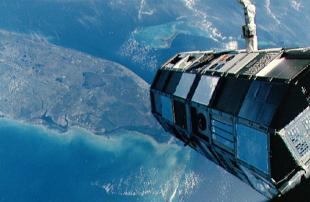Space debris
|
|
Space debris or orbital debris, also called space junk, are the objects in orbit around Earth created by man that no longer serve any useful purpose. They consist of everything from entire spent rocket stages and defunct satellites to explosion fragments, paint flakes, dust and slag from solid rocket motors, coolant released by RORSAT nuclear powered satellites, and other small particles. [1] (http://www.oosa.unvienna.org/Reports/AC105_720E.pdf)
According to Edward Tufte's book Envisioning Information, space debris objects have included a glove lost by astronaut Ed White on the first American space-walk, a camera Michael Collins lost near the spacecraft Gemini 10, garbage bags, a wrench and a toothbrush. Most of those unusual objects have re-entered the atmosphere of the Earth within weeks due to the orbits they were released at and their small sizes. Things like these are not major contributors to the space debris environment. On the other side, explosion events are a major contribution to the space debris problem. About 100 tons of fragments generated during approximately 200 such events are still in orbit. Space debris is most concentrated in low Earth orbit, though some extends out past geosynchronous orbit.
Space debris has become a growing concern in recent years, since collisions at orbital velocities can be highly damaging to functioning satellites and can also produce even more space debris in the process. Some spacecraft, like the International Space Station, are now armored to deal with this hazard. Also astronauts on EVA are vulnerable; see Extra-vehicular activity.
Clouds of very small particles are not as serious but cause erosive damage, like sandblasting.
Mitigation measures
Spacedebris_small.png
In order to mitigate the generation of additional space debris, a number of measures have been proposed: The passivation of spent upper stages by the release of residual fuels is aimed at decreasing the risk of on-orbit explosions that could generate thousands of additional debris objects.
De-orbiting satellites at the end of their operational life would also be an effective mitigation measure. This could be facilitated with a "terminator tether," an electrodynamic tether that is rolled out, and slows down the spacecraft. [2] (http://www.space.com/businesstechnology/technology/technovel_tether_041117.html) In cases when a direct (and controlled) de-orbit would require too much fuel the satellite can also be brought to an orbit where atmospheric drag would cause it to de-orbit after some years. Such a maneuver has been successfully performed with the French Spot-1 satellite in the end of 2003. It will re-enter in approximately 15 years.
In orbital altitudes where it would not be economically feasible to de-orbit a satellite, like in the geostationary ring, they are brought to a graveyard orbit where no operational satellites are present.
Proposals have been made for ways to "sweep" space debris back into Earth's atmosphere, including automated tugs, laser brooms to vaporize or nudge particles into rapidly-decaying orbits, or huge aerogel blobs to absorb impacting junk and eventually fall out of orbit with them trapped inside. However, currently most effort is being devoted to prevention of collisions by keeping track of larger debris, and prevention of more debris.
Space debris measurements
The United States military is maintaining a catalogue currently containing about 10,000 objects, also to prevent misinterpretation as hostile missiles. Observation data gathered by a number of ground based radar facilities and telescopes as well as by a space based telescope [3] (http://www.ll.mit.edu/ST/sbv/sbv_table_of_contents.html) is used to maintain this catalogue. Nevertheless, the majority of debris objects remain unobserved. There is an approximate number of 330 million debris objects larger than 1 mm in orbit (according to the ESA Meteoroid and Space Debris Terrestrial Environment Reference, the MASTER-2001 model).
Other sources of knowledge on the actual space debris environment include measurement campaigns by the ESA Space Debris Telescope, TIRA [4] (http://www.fas.org/spp/military/program/track/klinkrad.pdf), Goldstone radar, Haystack radar [5] (http://www.haystack.mit.edu/), and the Cobra Dane phased array radar [6] (http://www.fas.org/spp/military/program/track/cobra_dane.htm). The data gathered during these campaigns is used to validate models of the debris environment like ESA-MASTER. Such models are the only means of assessing the impact risk caused by space debris as only larger objects can be regularly tracked.
Returned space debris hardware is also a valuable source of information on the (submillimetre) space debris environment. The LDEF satellite deployed by STS-41-C Challenger and retrieved by STS-32 Columbia spent 68 months in orbit. The close examination of its surfaces allowed the analysis of the directional distribution and the composition of debris flux. The EURECA satellite deployed by STS-46 Atlantis in 1992 and retrieved by STS-57 Endeavour in 1993 could provide additional insight.
The solar arrays of the Hubble Space Telescope returned during missions STS-61 Endeavour and STS-109 Columbia are an important source of information on the debris environment. The impact craters found on the surface were counted and classified by ESA to provide another means for validating debris environment models.
See also
Template:Commonsde:Weltraumschrott fi:Avaruusromu fr:Débris spatial ja:宇宙のごみ nl:Ruimteschroot ru:Космический мусор

